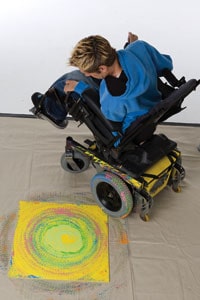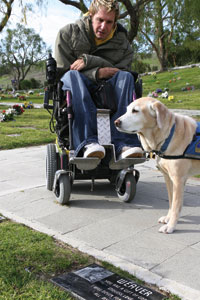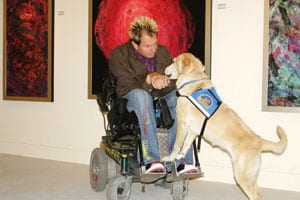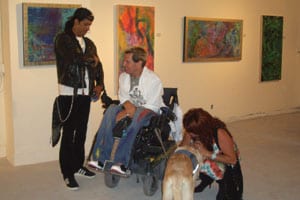

Tommy Hollenstein’s artwork is colorful and chaotic yet infused with the optimism and transformative drama that define the Southern California experience. Tommy is a native Angelino ex-surfer boy who sports a mini-Mohawk bleach job and a tanned and mellow Valley boy manner. He’s been getting lots of traction, so to speak, with his work. He paints by joystick — that is, with the tires of his power wheelchair — rolling through paint spilled on the floor, or with a dab of color coated on the tires to layer colors toward a unique, complex whole. He calls it a sort of “action painting.”
It’s a slow and thoughtful process as a work is built up layer by layer. He starts with a quarter-inch masonite board, which an assistant has primed and covered with a base color. He puts it on the floor and looks over the side of his power chair to master the paint hitting the board. “I just start working it,” he says. “As each piece speaks to me, I keep on working the paint. It’s like dancing as I spin back and forth and slide the tires.” Tommy says he sometimes thinks about his surfing days as he moves and slides on the boards. There is indeed an endless summer feel to some of the work.
 He uses front and rear tires, swirling bright and sometimes hot colored paint in patterns, lines or circles. There is a rhythm, a sort of syncopation in color. Once he lays down a tone, even just a small patch, he stops to hose off the tires, lets the first paint dry then adds a new layer. A single painting may take several weeks to complete, and may have as many as 50 layers of paint.
He uses front and rear tires, swirling bright and sometimes hot colored paint in patterns, lines or circles. There is a rhythm, a sort of syncopation in color. Once he lays down a tone, even just a small patch, he stops to hose off the tires, lets the first paint dry then adds a new layer. A single painting may take several weeks to complete, and may have as many as 50 layers of paint.
Once complete, he names them, all with a single word. There’s one called “Expect.” And “Freedom,” “Soar,” or “Beyond.” Says Tommy, “I want people to go get a positive feeling, to move beyond their expectations, their limitations, including people who are not disabled. Go do something you dreamed about as a child. That’s what I did.”
Tommy grew up in the San Fernando Valley, one of five children. His mom, Jean, who was in the Marine Corps before moving to California and getting married, ran a strict household. “Tommy, he always loved life and he lived life,” she says. “He always pushed his limits. He’d be in trouble but he never cared. You could see it in his eye. If I’d have him stand in the corner with his hands behind his back, he’d lean forward and draw pictures on the wall with his tongue.”
Tommy’s gimp story, familiar to longtime readers of New Mobility, began in March 1985. He had been 28 days sober and was just about to graduate from the Nick Harris private detective school, which appealed to him mainly because you could get a degree fast (“Nine months, I can do that,” he says). Then Tommy crashed his mountain bike, hitting a trench at the bottom of a grade. He soon enough discovered the full abstraction of quadriplegia and while living at home began to make the rounds, again, in the L.A. demimonde.
He got the private dick diploma and got some work, but Tommy wanted to be a gumshoe sleuth in the classic L.A. noir style. “I wanted to use high-tech gadgets and do surveillance. All they had for me was missing person or asset location stuff, just desk work.” Falling back on a meager Social Security income brought out the entrepreneur/pirate in him. Alas, sales of various recreational products led to use and abuse, then came the bust: two kilos of coke, a posse of 17 FBI agents with guns pulled. Tommy caught a break in the courts, avoiding jail time. He got sober, later went off the wagon, and eventually, found religion and sobriety for good.
Tommy says he’d wanted to be an artist since he was 5. But without any use of his hands, he didn’t see how. Mouthstick painting didn’t appeal to him. “They tried to teach me in rehab, but it was just too confining. I felt boxed in; it wasn’t flowing. I basically didn’t do anything for 12 more years.”

The redemptive art story begins with Weaver, a service dog. Man and dog had a preternatural, almost psychic bond. Tommy explains that Weaver got old and had had a stroke. Once he knew the dog was not long for life, he set about to make a tribute: “I said, I’d better hurry up and do this. We set up a studio in an empty shop and I literally poured puddles of paint on a canvas so I could roll through it and Weaver could walk through it. I just wanted to see tire tracks and paw prints.”
The result was more than a keepsake. It was epiphanous. Fireworks ignited in Tommy’s imagination; he realized he had colors and shapes and feelings bubbling up. He experimented with paints and surfaces, developed the layered style that some regard as Jackson Pollock-like, rolled through many quarts of Disney-like paint, and here we are after another 12 years.
He says he felt like a real artist, a working professional, after his first solo show, in 2005. He sold nine paintings, “not just to family and friends trying to make a guy feel good,” including two to actor Joaquin Phoenix, who he had met through a friend. He has had a few shows in the L.A. area, has shown in New York and Boston and has two Christian-themed paintings set to tour major U.S. cities before heading for Paris.
He has steadily been selling paintings, some to local celebrity folk (writer Dean Koontz has one on order; musician Nick Hexum has one), some to serious collectors, while still trying to avoid being relegated to the island where the fickle art world sends those who overplay their gimmick.

Abstract art isn’t everyone’s cup of tea, including Tommy’s mother. She said she didn’t really dig her son’s art scene until one day she was attracted to one among a batch Tommy showed her. It resonated, subconsciously. “He told me he did that the night I went in for surgery. He really captured the emotion and feeling of the experience.”
Lisette Ackerberg and her late husband Norman love the abstract, assembling one of the premier contemporary art collections in Southern California. They were drawn especially to the eclectic abstractions of Franz Kline, David Hockney, Sam Francis, Larry Rivers and Frank Stella. The Ackerberg house, on the Malibu beachfront, is a work of art itself (designed by Richard Meier, who also did the spatial Getty Center just up the road). Works by Picasso and de Kooning are included here. And on the wall of Lisette’s bedroom, there’s a Tommy Hollenstein piece called “Unseen.” The work has a cool tension and a kinetic energy, but its overall effect is quite soothing.

“Each painting we acquired talked to me,” says Lisette. “We always collected what we liked. Tommy’s work brings happiness to my soul. It gives me joy.” Here’s how this connection formed, and of course, there’s a dog in the story.
Lisette first met Tommy at an adaptive van shop where he worked. Her husband Norman, who had made his fortune in commercial real estate, and who had multiple sclerosis, was a customer. One day Norman was asking around about getting a service dog to help him out. Tommy had been associated with the Canine Companions group for years; that’s where Weaver came from. The program, however, had a waiting list of many years. Tommy arranged for the Ackerbergs to get what they call a release dog — one that didn’t make the cut after training, usually because some basic dog behaviors, such as chasing a ball or being distracted by poodles, wouldn’t wash out in training.

Some time later, Tommy invited Lisette and Norman to a showing of his art in Los Angeles. “I was flabbergasted,” she says. “Tommy’s work just radiates passion. It has movement. Each one is so vibrant. They instill in me a feeling of peace, of tranquility. Some of them, you can’t tell they were made by a wheelchair.”
Tommy sends 10 percent of each sale to Canine Companions (www.cci.org), as a tribute to Weaver. One of Tommy’s goals is to make enough of a living to “get off the system” of Social Security-enforced poverty. “I want to show it can be done,” he says.
In the Internet world, the customer can find the artist easier than vice versa. L’Attitude is a contemporary gallery on tony Newberry Street in Boston that is showing a couple of Tommy’s paintings, which got there by way of a Google search. “We found him by searching for ‘wheelchair artist,'” says Binky Merrill, an art consultant for the shop. “We had a job to provide artwork for the walls of the new occupational therapy and physical therapy wings of the Children’s Hospital in Boston.” This was to be the art for the waiting rooms, exam rooms, hallways, etc. “While researching the artwork, we found Tommy on Google, about 35 pages down. He’s got a great website [www.tommyhollenstein.com] and we called him right away.” The gallery bought two paintings they saw online. “They were vibrant and colorful and we thought they’d be inspirational for the kids.”

Last year the gallery put together a show of Tommy’s work in the hospital lobby — 14 of his pieces were on display for six months. During this time the hospital hosted an art workshop for the kid patients. They convinced Tommy to come out and he brought along his mom and dad, attendant and current dog, Hiley. “He showed the kids how to paint with their own wheelchairs.” Binky, Tommy and his mom described this event in transcendent terms.
Tommy’s mom, Jean: “It blew my mind to see the patience he had, to see him work with those kids. There was one little boy who had had brain surgery but hadn’t spoken in two weeks. Tommy asked him what his favorite color was. He said, ‘red.'” This rocked the house. “The boy’s mother came up to me crying,” says Tommy, who is still in touch with the boy.

“Tommy, through his artwork, tells his story, what he’s been able to create with his life,” says Binky. “It’s abstract but upbeat. He has a really good design sense and color sense. He’s pushed this media to the limit, a media that he’s invented. It’s arresting to see them without knowing his story, but as it is with any artwork, the more you know about the artist, the more interesting is the work.”

And sometimes, all it takes is a little help from a friend. Rock star Saul Hudson — you’d know him better in a top hat, cigarette on his lip, as Velvet Revolver guitarist Slash — bought a Hollenstein piece called “Propel.” Slash and Tommy are friends. I’m not going into detail how or where they met — suffice it say they had truck with some of the same demons and took a similar path toward the gates of redemption. Slash used fatherhood as an excuse to clean up. That and having his heart stop for eight minutes a few years ago.
So, Tommy invited Slash to a show, and he showed up with wife and young boys. “I’m not a collector as such,” says Slash. “Now and then I pick something up if it’s cool and not astronomically priced. I went to Tommy’s show in L.A., you know, as a favor. But it was f-king brilliant. The paintings were expressive and explosive. The amount of effort in them is hard to fathom.” The painting Slash owns is electric blue over red, swirling with joyful rage. Would Slash own a Hollenstein painting had he not known the artist? No, probably not, but Slash says that sets up the point he wants to make: “The coolest thing is that Tommy can be successful on the basis of his work. The process is interesting, but you don’t need to know about that to like it.”
If Tommy could write his own script, he’d get a gallery or agent to represent him so he can concentrate on art, not marketing. He wants to be taken not as a disabled artist but as an artist artist. “I’ve had plenty of denial letters. I keep them in a file and use them to get me more motivated. The way I see it, a rejection is just one man’s opinion.”
Where the Colors Come From



Tommy Hollenstein tried lots of paints before settling on Behr products. He likes their texture and Disney palette, including colors such as Get Goofy, Friendly Frog, Mouse Ears and Tiggerific. Tommy sent a note over to the Behr company, asking if they could help him out. “The head guy got right back to me and asked how much paint I needed. I said I ran through $300 to $500 a month. He said save the receipts, send them over, we’ll take care of it. They’ve been terrific.”
“We were inspired by his story and his art,” says Drew Hatcher, director of contract management for Behr. “You see his work, you can’t help but be uplifted. Seeing them in person adds so much more. They’re alive. They’re compelling.”
Support New MobilityWait! Before you wander off to other parts of the internet, please consider supporting New Mobility. For more than three decades, New Mobility has published groundbreaking content for active wheelchair users. We share practical advice from wheelchair users across the country, review life-changing technology and demand equity in healthcare, travel and all facets of life. But none of this is cheap, easy or profitable. Your support helps us give wheelchair users the resources to build a fulfilling life. |


Recent Comments
Kevin Hoy on TiLite Releases Its First Carbon Fiber Wheelchair
tuffy on NYDJ Launches Women’s Adaptive Jeans on QVC
Lisa Cooley on How to Fund an Expensive Adaptive Vehicle